Over 40% of men will experience some form of hair loss by the age of 40. When men experience hair loss, they tend to lose hair first in their hairline and then lose the hair on their crown. In some instances, men may experience a thinning crown but no receding hairline. For men who experience balding on both ends, the hairline matters the most because it’s at the front of the face. Hairline recession is understood as the most prevalent sign of baldness. However, for others, the crown is more important.
The major dilemma with traditional hair transplant surgery is that patients have to choose between prioritizing their hairline or crown. This is primarily due to a limited donor supply on the head. Many individuals want to address their receding hairline but may have to face a minimal crown coverage form.
However, with a greater number of hair transplant grafts, patients can achieve ideal results for both the hairline and the crown. What makes this possible is the advent of an advanced Follicular Unit Extraction (FUE) technology developed by Dr. Umar, called the Dr.UPunch intelligent™ that enables the safe extraction of follicles from other areas of the body, not just the head. Essentially, using non-traditional sources from the beard, body, and nape expands the donor supply and offers new possibilities for attaining the best possible coverage in the crown and the hairline.
Before Dr. U, this patient had a hair transplant focused on the frontal scalp at the crown’s expense. The result is unwholesome as a result.

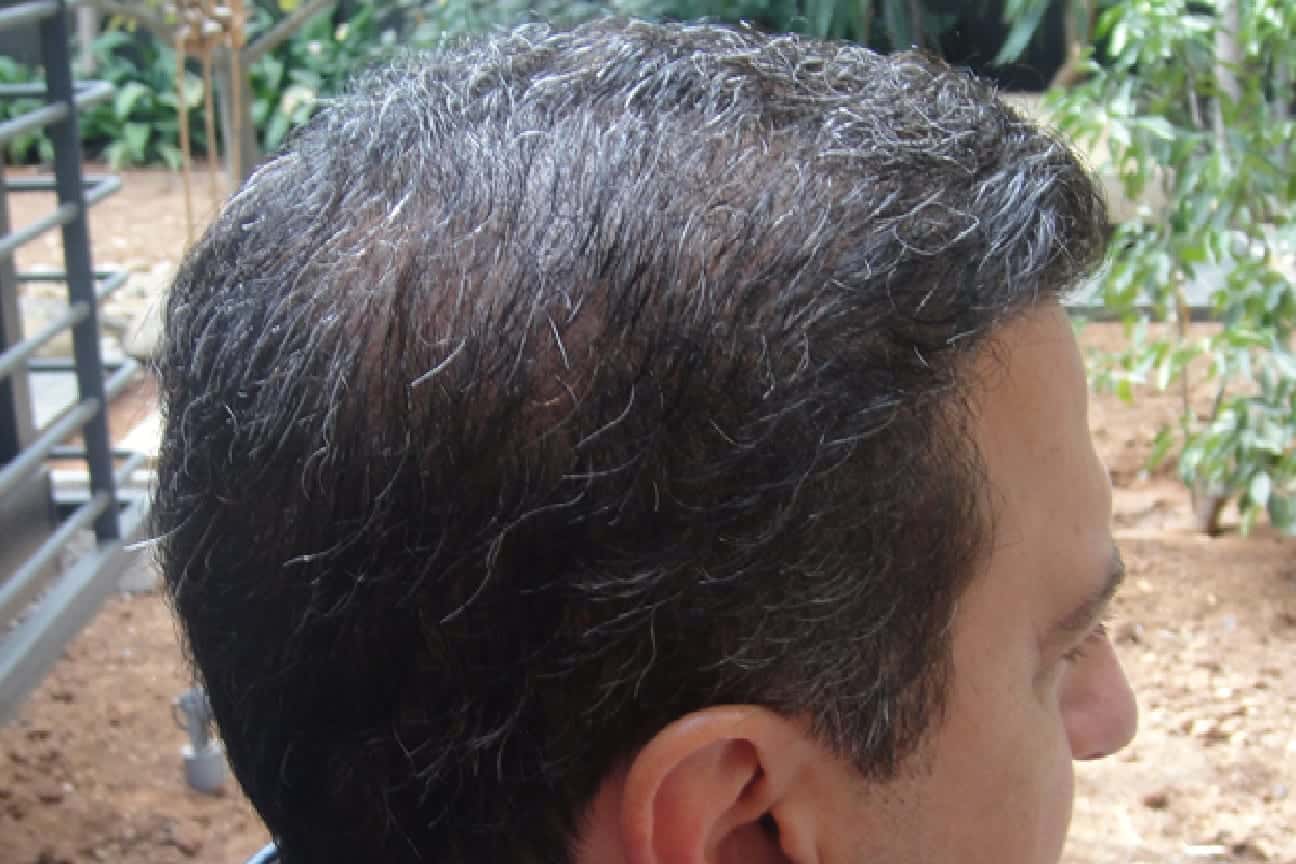
Multiple Hair Plant Surgeries: Treatments For Combating Crown Hair Loss In Males
When you want to stop a balding crown, it’s easy to get overwhelmed and impulsively choose treatments that market the claim as being quick and easy. But if you truly want to combat hair loss, you will have to be strategic and look into viable long-term strategies. Though various treatments exist for combating crown hair loss in males, they come with major disadvantages.
Propecia (Finasteride)
Propecia manages hair loss by blocking a byproduct of testosterone called DHT. Though the idea of just taking a pill a day might seem convenient, this medication comes with serious side effects like dizziness, sexual impotence, and headaches.
Rogaine (Minoxidil)
Rogaine is an over-the-counter topical medication that can be applied to the crown of the head. Results are highly variable, and regrowth is not guaranteed.
Strip Surgery
Strip surgery transplants use strips of hair-bearing skin. Follicles are essentially transplanted from the back of the head to the front. Due to the coarser caliber of hair found in this area, hairlines created from the back of the head often look harsh and unnatural. A strip surgery transplant could also be used to combat crown hair loss in males, but patients will inevitably have a permanent linear scar on the back of their head.
Wigs
A wig — often referred to as a toupee — can disguise crown hair loss in males. However, wigs don’t offer a long-term solution for the problem and can easily slip off or become damaged. The tendency for toupees to look slightly artificial also defeats the purpose of using them to disguise hair loss.
Planning Your Hair Transplant With Dr. Umar: The Smartest Choice For The Crown
A successful crown hair restoration requires two elements to be in place:
- harvesting a sufficient number of donor grafts
- inserting the grafts to recreate the crown whorl’s natural hair growth pattern.
Dr. Umar works with patients and their budgets to determine an appropriate number of grafts to cover the crown area. If needed, additional grafts can be obtained from body regions.
Here are examples of two patients who could achieve the coverage they wanted for both the hairline and the crown without sacrificing one for the other.
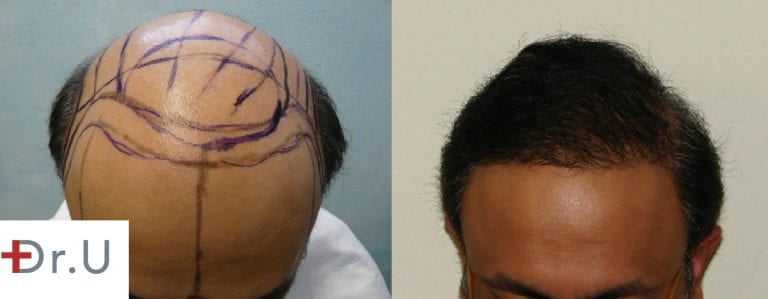

The insertion phase of a crown hair transplant is particularly complex because of the crown whorl. Unlike the rest of the head, hair at the crown grows in a spiraling pattern. Everyone’s whorl is different. And some individuals have two whorls. On top of that, the hair on the crown grows in different directions, and the hair in the center of the whorl area also tends to be finer. Hence, to have an authentic, natural-looking crown, the patient will need surgeons who are well-equipped and experienced with this intricate procedure. With Dr. Umar, patients can expect to have their hair loss be assessed as a unique problem with a unique solution.
Why a Hair Transplant For the Crown With Dr.UGraft™ Is Ideal
The crown area tends to require many grafts to achieve the appearance of a fuller coverage. Dr. Umar’s UGraft advanced FUE surgery is ideal for meeting the needs of hair restoration procedures for the crown. The main reasons are as follows:
Use of Body hair: Dr. Umar extracts hair from areas —like the nape and the rest of the body — that is finer and better for the crown. Besides, if you have experienced a significant amount of hair loss in both the crown and hairline, With Dr. Umar’s advanced FUE surgical tools, which take hair from all over the body, many patients can acquire enough donor grafts to achieve the coverage they desire for the crown.
Minimal Scarring: The cutting axis of the Dr.UPunch intelligent ™ allows wounds to heal smaller and flatter compared to the wounds created by basic FUE punches.
No Stitches: Dr.UPunchintelligent ™creates small wounds that heal on their own and are often undetectable.
No scalpels and knives: Dr. Umar created the Dr.UPunch intelligent ™ — a unique tool that allows surgeons to acquire grafts safely.
Potential to have a short haircut: Because there is minimal scarring, sufficient coverage, and a natural-looking result, patients that prefer to keep their hair short can do so without the fear of visible bald spots or scars.
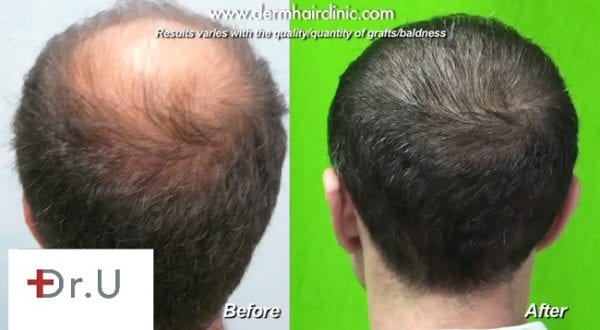
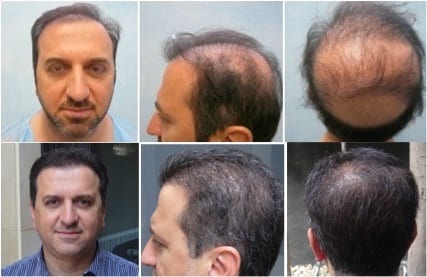
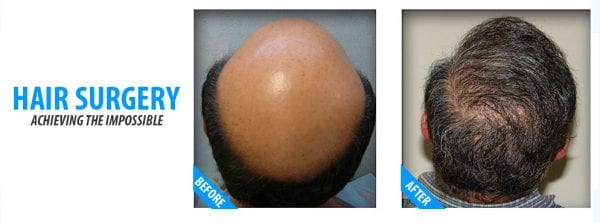
With traditional FUE, which uses grafts from the head, a limited donor supply can hinder patients from getting the type of coverage they want for both the hairline and the crown. But this no longer has to be the case with technology like the Dr.UPunch intelligent ™, which has been specifically engineered to harvest follicles from all over the body safely. Patients can indeed get the fullness they want in both the crown and the hairline without necessarily having to choose one over the other.
Frequently Asked Questions: Hair Transplant for the Crown
When planning your hair transplant, how do you decide between getting a hair transplant for the crown or restoring your hairline?
The answer to this question depends on two things:
- the patient’s preference when having to choose between one or the other due to a limited donor supply
- the patient’s budget, which would affect the graft count that is used for a single surgery
Therefore, when faced with the challenge of a limited number of grafts, patients would need to depend on their personal preference on which area to prioritize. Some people might prefer having a more youthful-looking hairline to frame their upper face. Others believe that crown hair loss is a more salient sign of baldness and would prefer to address this first.
In the patient example above, the hairline was prioritized at the crown’s expense, leaving results that appeared extremely awkward and unnatural. Therefore, if budget is not a concern, it would be best to opt for a specialized form of surgery where body hair can be safely removed using specialized technology like the Dr.UPunch intelligent ™ to produce a large enough donor quantity that can offer coverage for both the hairline and the crown.
Are there any natural remedies to stop a balding crown?
There are no proven natural remedies that can actually stop a crown from balding at this moment in time. However, some studies show that certain plant extracts might help manage or improve hair loss in some patients.
Do you have male pattern balding if you only have a balding crown but no receding hairline?
It is certainly possible to experience male pattern baldness through hair loss in the crown area without the hairline being affected. Although this occurrence is different from what is normally depicted on the Norwood scale, some people experience different hair loss patterns.


